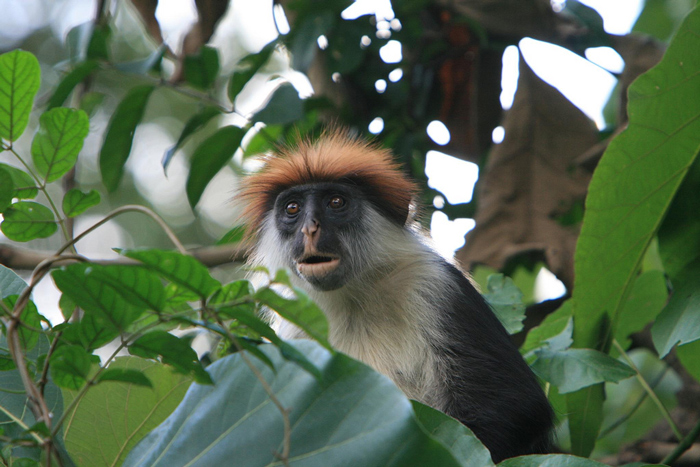Sanje Waterfalls is by right, the longest waterfall in the whole of East Africa. With waters falling at an impressive 550-foot-long stretch vertically this is without a doubt, Tanzania’s largest waterfall with a rough measurement of 170 meters in height. The hike to the waterfalls is kind of strenuous but the tracks are well-maintained. You also get the chance to see its endemic wildlife like the Iringa Red Colobus monkey.
Udzungwa Mountains National Park, or “Hifadhi ya Taifa ya Milima ya Udzungwa” in Swahili, is located in the Kilolo District of Iringa Region and the Kilombero District of Morogoro Region in Tanzania. Spanning 1,990 square kilometres, the park is primarily set in Kilolo District and features a diverse range of habitats from tropical rainforests to miombo woodlands, grasslands, and steppes. Elevations range from 250 to 2,576 meters, culminating at the peak of Luhomero, which is part of the Eastern Arc Mountains. The park is known for its rich biodiversity, boasting over 400 bird species, 2,500 plant species, and 6 primate species, making it Africa’s second most biodiverse national park.
Sanje Waterfall, stands out as one of the tallest waterfalls in the national park system of Tanzania, with a total height of approximately 270 meters. This waterfall is not just a scenic attraction but a fascinating natural phenomenon divided into three distinctive stages:
- First Stage: This is the most prominent section at 170 meters.
- Second Stage: A smaller drop of 30 meters.
- Third Stage: The final 70 meters, located about 3.2 kilometres towards the peak.
A Natural Oasis for Visitors:
Sanje Waterfall offers a serene and rejuvenating environment for visitors. After a challenging hike, tourists are greeted by the sight of cascading water, which collects into small natural pools ideal for swimming, relaxation, and play. This waterfall essentially serves as a natural swimming pool, providing a unique experience.
The Hidden Wonder: The Map of Africa
One of the most extraordinary features of Sanje Waterfall, particularly at its 170-meter section, is that it naturally forms an outline resembling the map of Africa. This geographical wonder depicts the continent’s boundaries as they might appear on a map, including elements that mirror the actual climate and geography of different regions:
 Natural Depictions: The impact of the waterfall on the surrounding vegetation sometimes results in areas that resemble deserts, notably where the Sahara would be located on a map.
Natural Depictions: The impact of the waterfall on the surrounding vegetation sometimes results in areas that resemble deserts, notably where the Sahara would be located on a map.
Visitor Discovery and Interaction:
Interestingly, this hidden feature often goes unnoticed by many visitors unless pointed out by keen observers or informed by the park’s guides. An example of this is a group of students from Sokoine University of Agriculture, who were on a field trip for their Wildlife Management studies. Only a few noticed this unique aspect of the waterfall after it was highlighted by Mr. Stanford, one of the park’s guides.
Guides sometimes withhold this information to see if visitors can discover this feature themselves, adding an element of adventure to the visit. However, if not noticed, they reveal this fascinating detail at a resting point after the hike, enhancing the visitor’s experience with this unexpected educational gem.
Why Visit Sanje Waterfall?
Whether for study, exploration, or simply to enjoy the tranquility of nature, Sanje Waterfall provides an outstanding experience. This site is not just about the trek or the view; it’s an opportunity to witness a natural artwork that educates and amazes, offering insights into geography, ecology, and the wonders of nature’s creativity.
 The Allure of Sanje Waterfall: Sanje Waterfall, a highlight of the park, stands at an impressive 170 meters, making it one of East Africa’s tallest waterfalls. This natural wonder is nestled within the lush rainforest of the Udzungwa Mountains, attracting tourists for its scenic beauty and the adventure of reaching it.
The Allure of Sanje Waterfall: Sanje Waterfall, a highlight of the park, stands at an impressive 170 meters, making it one of East Africa’s tallest waterfalls. This natural wonder is nestled within the lush rainforest of the Udzungwa Mountains, attracting tourists for its scenic beauty and the adventure of reaching it.
Hiking to Sanje Waterfall:
- Guided Tours: Hikes to Sanje Waterfall are facilitated by experienced guides from the park. These guides provide insights into the local flora, fauna, culture, and history. The journey starts at the park headquarters where a briefing on hiking rules and regulations is given.
- The Trek: The trail winds through dense forest, showcasing towering trees, exotic flowers, and a variety of wildlife, including rare species like the Udzungwa red colobus, the Iringa red colobus, and the Sanje mangabey. The trek, which can take about 3-4 hours one way, becomes more thrilling as the sound of the waterfall grows louder, leading to the spectacular view of the cascading water.
- At the Waterfall: Upon reaching the waterfall, visitors can enjoy the breathtaking sight of water plummeting from the cliff, creating a misty spray and often a rainbow. The base of the falls features a pool where one might be tempted to swim, though caution is advised due to currents and slippery rocks.
Cultural and Additional Activities:
- Cultural Exchange: The hikes offer more than just natural beauty; they provide a chance to engage with local communities, learning about their traditions, trying local foods, and understanding their sustainable lifestyle with nature.
- Other Activities: Beyond hiking, the park offers:
- Birdwatching: With its status as an Important Bird Area (IBA), bird enthusiasts can spot over 400 species.
- Nature Walks: Guided walks that educate visitors about the park’s endemic plants and animals.
- Mountain Biking: Trails for those looking to explore the park on two wheels.
- Canopy Tours: The Mwanihana trail offers a unique perspective from the forest canopy, potentially spotting endemic primates.
Sanje Mangabey & Iringa Red Colobus Monkeys
In 1979, researchers Katherine Homewood and Alan Rodgers were conducting a study on Udzungwa red colobus monkeys in the Sanje Valley, part of what was then known as the Mwanihana Forest Reserve in Tanzania’s Udzungwa Mountains. During their study, they were familiar with several other local monkey species including the Angolan black and white colobus, Moloney’s or blue monkey, and the yellow baboon.
One day, while ill with malaria and confined to her tent, Katherine Homewood heard an unusual and distinct call that she initially believed to be a hallucination or a prank by her colleague, as the call belonged to a mangabey monkey. Mangabeys were known to be found either 400 miles north in Kenya’s Tana River or in the distant Congo rainforests, far from where she was. Intrigued, she inquired with their local guide, who identified the call as belonging to a monkey known locally as the ng’olaga. The guide expressed surprise that the researchers were unaware of this species.
Intrigued by this revelation, Alan Rodgers asked the guide to show him these ng’olagas. The guide led him into the forest where they encountered a troop of these monkeys, leading to the discovery of a previously unknown population of mangabey monkeys. They named this newly discovered species the Sanje mangabey, after the nearby Sanje River and waterfall.
Conservation Efforts and Further Studies:
Limited Distribution: Subsequent surveys confirmed that the Sanje mangabey is only found in two isolated forests within the Udzungwa Mountains, making it one of the rarest and most endangered primates in the world.
Habituation for Research and Tourism: Since their discovery, efforts have been made to habituate several troops of Sanje mangabeys. Habituation involves the monkeys becoming accustomed to human presence, allowing researchers to observe and study their behaviour closely without disturbing their natural activities. This process also enables tourists to visit and observe these endangered primates, contributing to conservation efforts through eco-tourism.
This story not only highlights the unexpected biodiversity of the Udzungwa Mountains but also underscores the importance of local knowledge in scientific discovery and the ongoing need for conservation efforts to protect such rare species. The Sanje mangabey’s existence in this isolated area points to the unique ecological niches that can still surprise scientists, even in well-studied regions.
Frequently Asked Questions:
- Difficulty of the Hike: The hike is moderate to difficult, with steep, potentially muddy and slippery paths. It usually takes 3-4 hours to reach the waterfall and another 2-3 hours back.
- Guide Requirement: Yes, a guide is mandatory for safety and to enhance the experience with their expertise.
- Wildlife Encounters: Expect to see various species including monkeys, antelopes, and an array of birds.
- Swimming: Swimming at the base of the waterfall is not recommended due to safety concerns.
- What to Bring: Essentials include water, snacks, sunscreen, insect repellent, a hat, camera, and appropriate hiking gear.
- Additional Safari Activities: Combine your waterfall hike with birdwatching, nature walks, mountain biking, or cultural engagements for a holistic safari experience.
Sanje Waterfall offers not just a physical journey but a deep dive into the natural and cultural heart of Tanzania, providing an unforgettable adventure where tranquility meets adventure.
- Hike to Kwa Mambori Waterfalls in Old Moshi
- Maio waterfall
- Napuru Waterfalls in Mount Meru and Picnic Site in Arusha
- Tululusia waterfall
- Momella Lakes
- Themi Water Falls – Waterfalls at Themi River
- Materuni Waterfalls from Arusha
- Karura Caves & Waterfalls
- Kikuletwa or Chemka Hot Springs Day Tour
- Marangu Day Trip, Waterfalls and Village Tour
- Materuni Waterfalls and Coffee Tour
![]()



